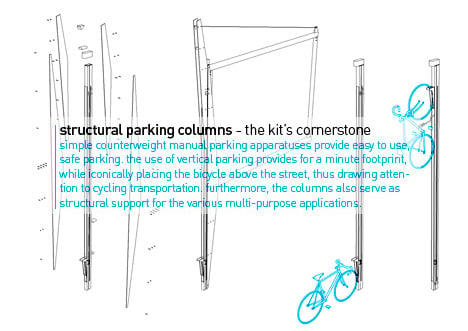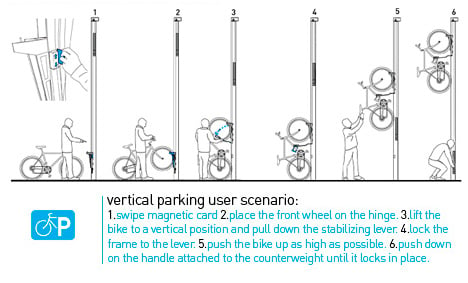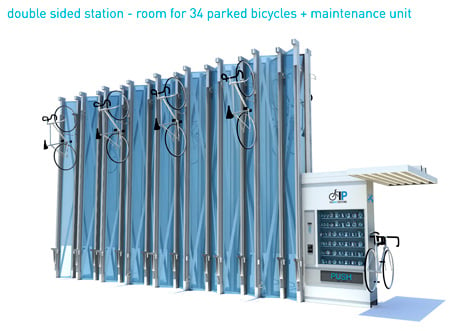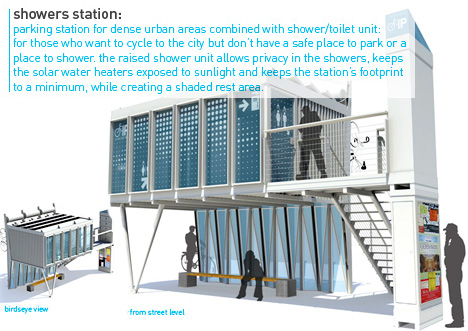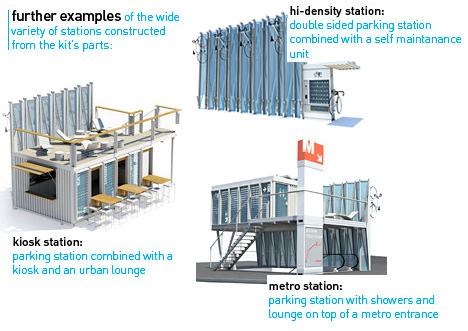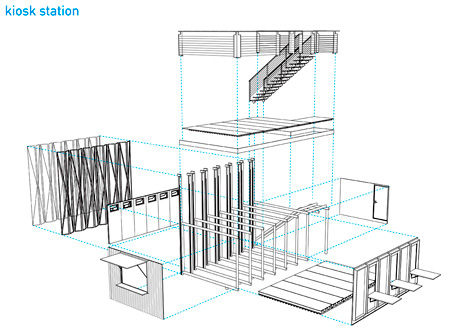December 16, 2009
MIT announce The Copenhagen Wheel
November 30, 2009
Copenhagen 1937
Thanks to Inari at Cycle Consultants, Helsinki, part of British Council's Challenge Europe Climate Advocacy programme, for putting me on to this wonderful video of Copenhagen back in the day.
James A. Fitzpatrick's Traveltalks The Voice of the Globe
James A. Fitzpatrick's Traveltalks The Voice of the Globe
November 12, 2009
NYC Bike Fashion Show

Chic cycling, street style at 'Bike Style' fashion show in NYC. Credit: Emma Grady
Hudson Urban Bicycles (HUB) in the West Village, New York City, hosted Bike Style Saturday night, a fashion show premiering chic urban cycling looks. Friends of HUB donned tailored bicycle wear--blazers, cropped pants, and caps--from designers Lela Rose, Reiss, Sheila Moon, and Outlier; strutted and danced 'cross the runway to DJ jams; mounted European-origin bikes from Batavus, Abici, Moof, and Linus, and rode out into the rainy NYC night. Click through for our videos--the def jams might have you chair dancing--and more photos from the show.
Norreport Station CPH
Copenhagen based COBE Architect have won first prize for their bike friendly station design
COBE Architects blasted away its competitors with a sexy and bike-friendly new design in the recent competition to redesign Copenhagen’s Norreport train station. Almost retro in its lines, the architects’ vision of the new station is composed of a series of rounded, floating roofs set upon striking glass pavilions. Since bicycles are a preferred means of transportation in Copenhagen, ample bike parking was a main feature of the new structure, and other green features will include energy-efficient lighting and natural ventilation
Norreport Train Station is the busiest train station in the Danish capital, with over 25,000 people bustling through it daily. The main stipulations for the updated transportation hub were that it be able to accommodate lots of passengers and lots of bikes, and also be a place where people can gather and connect with one another. In an effort to make the station even more convenient, passengers can easily be dropped off on the street alongside their desired entrance, or ride their bikes and leave them at the station.
Eleven ventilation towers are placed around the plaza, which will help naturally cool and ventilate the train platform below. These towers also act as information boards and plaza lighting, utilizing LED screens and energy efficient lighting to direct passengers to their departing trains. The towers can also be used for advertisements, announcements and cultural events.
Fahrrad und Bahn
Translated from stuttgart.de
The Bicycle and train are highly complementary. The way to the train station or bus stop can be wonderful to travel by bicycle. Once there, stand under the bike and ride in the city of Stuttgart is often covered parking available. At the main station and the S-Bahn station Schwabstraße bike boxes can be rented. At stations in Möhringen Vaihingen and take the employees of the bike service stations at the good plays.
Those who want to cycle at the destination may take their bicycle in urban and suburban trains usually for free. Restrictions apply during peak periods. Thus, the carriage of bicycles in the light rail is permitted between 6 am and 8.30 clock and not in the evening between 16 and 18.30 clock. In S-Bahn, DB regional trains and the trains of the Württemberg railway company TRAIL may always bicycles are taken away. However, due in the morning peak period between 6 and 8.30 clock a child ticket.
A peculiarity of Stuttgart is the bike transport rack of the Marienplatz to Degerloch. With the help of special Vorstellwagens the "wave" brings you your bike comfortable, safe and free of charge from the valley to the Filderebene.
A peculiarity of Stuttgart is the bike transport rack of the Marienplatz to Degerloch. With the help of special Vorstellwagens the "wave" brings you your bike comfortable, safe and free of charge from the valley to the Filderebene.
Photo: Stuttgart Department of City Planning and Urban Renewal
At stations in Möhringen and Vaihingen the staff of the bike service stations offer their services. Here bicycles can be parked safely. While the parking time from Monday to Fri from 7 am to 8pm you can clean his bike too, and wait. The bicycle service stations can also rent bicycles on offer. The donated and brought up to scratch bike can be rented for three to five euros a day.
The bicycle-service stations are open Monday to Fri from 7 20 clock. The prices for a "Bicycle Parking" as follows:
$ 0.50 per day
2 euros per week
5 Euro per month
50 euros per year
The bicycle-service stations are open Monday to Fri from 7 20 clock. The prices for a "Bicycle Parking" as follows:
$ 0.50 per day
2 euros per week
5 Euro per month
50 euros per year
Operated bicycle service stations from social enterprises "New Work". The employment project is helping young unemployed people on their way into a job on the first labor. Who his bicycle in a bicycle parked service station, so not only does his bike a good thing, but also helps in the integration of young unemployed.
Photo: Stuttgart Department of City Planning and Urban Renewal
Bike Boxes
Especially popular are the bike boxes at the central railway station at Schwabstraße. As in a mini-garage, the good pieces there are safe from thieves and protected from wind and weather. The bike boxes can be used for 5 euros or 50 euros a month in rent for the mobility counseling in the i-dot.
Photo: Stuttgart Department of City Planning and Urban Renewal
November 11, 2009
Re-Cycling
A friend of mine found a mint-condition mountain bike on a skip near his house recently – a prime example of “throwawayism”. According to Social Entrepreneur Ireland award winner Anne Bedos, it’s quite common for people to throw good bikes away. Rather than just get mad about it, Bedos decided to do something – she believes that salvaging abandoned bikes is an environmental imperative, and can also be used as an instrument of social change.
Her bicycle recycling organisation Rothar saves bikes from the scrap heap and works with at-risk people from Dublin youth groups to fix them up. The spruced-up bikes are then sold at a community-based bicycle shop, typically for less than €100. Genius.
Vélib Thievery
Vélib, the Parisian bike-sharing program, is great. But it would be incorrect to pretend that tout est parfait dans le meilleur des mondes (lit. transl.: everything is perfect in the best of worlds). Vandalism and theft has been a problem, and the latest news aren't good: About 80% of the original 20,600 bicycles have been damaged or stolen and the resources required to fix them or replace them are straining the program's budget. There's even a black market for stolen Vélib bikes in Eastern Europe and Africa...
The NYT writes:
There will always be a certain amount of vandalism (especially if France doesn't solve its problem with the alienation of the banlieues), but using such expensive bikes makes them a much bigger target for thieves who want to make a buck, and they inflate the replacement costs, making the whole scheme a lot less profitable (and thus sustainable) than it could otherwise be. It must be possible to make rugged bikes for less than that...
In some areas, it can be hard for would-be cyclists to find working bikes. But despite these problems, Vélib has had 63 million rentals since mid-2007 and surveys show that Vélib users are still happy with their experience.
It will be very interesting to see if, as other bike-sharing programs grow, they attract the same kind of problems as Vélib or if this is more of a specifically Parisian problem.
Via NYT + Treehugger
Many of the specially designed bikes, which cost $3,500 each, are showing up on black markets in Eastern Europe and northern Africa. Many others are being spirited away for urban joy rides, then ditched by roadsides, their wheels bent and tires stripped.The first thing that jumps at me is the reported cost of the bikes. Maybe the New York Times has bad information, but if the bikes really cost that much, that's probably the first thing that should be changed.
JCDecaux must repair some 1,500 bicycles a day. The company maintains 10 repair shops and a workshop on a boat that moves up and down the Seine.JCDecaux reinforced the bicycles' chains and baskets and added better theft protection, strengthening the mechanisms that attach them to the electronic parking docks, since an incompletely secured bike is much easier to steal. But the damage and theft continued.
There will always be a certain amount of vandalism (especially if France doesn't solve its problem with the alienation of the banlieues), but using such expensive bikes makes them a much bigger target for thieves who want to make a buck, and they inflate the replacement costs, making the whole scheme a lot less profitable (and thus sustainable) than it could otherwise be. It must be possible to make rugged bikes for less than that...
In some areas, it can be hard for would-be cyclists to find working bikes. But despite these problems, Vélib has had 63 million rentals since mid-2007 and surveys show that Vélib users are still happy with their experience.
It will be very interesting to see if, as other bike-sharing programs grow, they attract the same kind of problems as Vélib or if this is more of a specifically Parisian problem.
Via NYT + Treehugger
London - Paris Cycle Route
London-Paris cycle route planned for 2012
AFP - A cycle path linking London and Paris will be completed by 2012, French and British local authorities said here on Friday as they formally launched the "Avenue Verte" (Green Avenue) project.
"We want to symbolically link the Tower of London to the Eiffel Tower with an alternative mode of transport to the car that crosses landscapes of great quality," said Didier Marie, head of France's Seine-Maritime department.
The 350-kilometre (218-mile) "Avenue Verte" will use existing national cycle network routes in southern England, passing through the counties of Surrey and Sussex.
Cyclists will need to take a ferry across the Channel from Newhaven to Dieppe.
In France, the cycle path will follow a route through Normandy as it winds its way south to Paris.
The route will incorporate stretches of disused railway lines as well as using regular roads where cycles will have their own dedicated lanes.
"These (existing dedicated cycle paths) were built for tourism but we quickly noticed they were being used by people going to work," said Matthew Lock, a local councillor from the English county of East Sussex.
Amphibious Velomobile
From an ambitious inventor in the Czech Republic, we bring you the HEPAV — the Human Powered Electric Amphibious Vehicle.
How does it work? Simply put, the HEPAV 1.1 is a recumbent tricycle with electric assist and a buoyant shell that allows riders to drive directly into and out of ponds, rivers and lakes. Inventor David Buchwaldek says he designed the HEPAV 1.1 to be like a kayak in that it can be transported by vehicle but ridden directly into the water. Video proves the viability of Buchwaldek’s design, but it remains unclear how practical it is. The HEPAV 1.1 seems pretty slow in the water at this point.
Unfortunately, the HEPAV 1.1 is still far too expensive to build to be commercially viable, but that may not be the point of the vehicle. Buchwaldek’s process and thinking is enlightening in itself and worth a trip to his website,esoteric-david.eu. Among other projects documented there are a human-powered airplane, an innovative bike rack available for purchase, and appropriately ‘esoteric’ advice like Life Tips and Tricks #25. “Progress is the realization of utopias.”
Share Space
In the German town of Bohmte, the highway code has been abolished in order to create a common code to cardrivers, cyclists and pedestrians. (Report: B. Boussouar)
Via France24
Via France24
Innovative Fold-Up
Innovations in folding bikes have helped urban cyclists cram their vehicles into tiny apartments for years now--and the designs keep getting better and better, and smaller and smaller. And this new folding bike concept by Victor Aleman may take the cake--as you may or may not be able to tell, even the wheels fold up on this bad boy. More pics after the jump.
Via Tuvie
Sceptic about Electric Cars
You should be, Electric Cars will not be dramatically cleaner than those powered by fossil fuels until they rely less on electricity produced from conventional coal-fired plants, according to US National Research Council.
“For electric vehicles to become a major green alternative, the power fuel mix has to move away from coal, or cleaner coal technologies have to be developed,” said Jared Cohon, chair of a US National Research Council report released this week entitled Hidden Costs of Energy: Unpriced Consequences of Energy Production and Use.
About half of US power is generated by burning coal, which emits many times more of traditional pollutants, such as particulates and smog components, than natural gas, and about twice as much of the main greenhouse gas carbon dioxide.
Advances in coal burning, like capturing carbon at power plants for permanent burial underground, could also help electric cars become a cleaner alternative to vehicles powered by fossil fuels, he said.
Pollution from energy sources did $120 billion worth of damage to human health, agriculture and recreation in 2005, said the NRC report, which was requested by the US congress in 2005 and sponsored by the US department of the treasury.Electricity was responsible for more than half of the damage.
Electric cars have other benefits such as reducing imports of foreign oil. But they can have hidden costs. Materials in electric car batteries are hard to produce, which adds to the energy it takes to make them. According to the report, the health and environmental costs of making electric cars can be 20 per cent greater than conventional cars, and manufacturing efficiencies will have to be achieved in order for the cars to become greener.
Emissions from operating and building electric cars in 2005 cost about 20 cents to 15 cents per mile traveled, it said. In comparison, gasoline-powered cars cost about 0.34 cents to $5.04 per mile traveled.
The report estimated electric cars could cost more than gasoline-powered cars to operate and manufacture in 2030 unless power becomes cleaner.
"Our research has shown that on average our electric vehicles' 'well to wheel' lifecycle emissions are 59 per cent lower than petrol cars. But in France, where electricity is primarily generated using nuclear, emissions are 97 per cent lower," he argues.
Hybrid gasoline-electric vehicles with batteries charged by the driver braking scored slightly better than both gasoline-powered cars and plug-in hybrids, which have batteries that are charged by the power grid.
– Reuters
Biking in NYC
NYC DOT explains Bike Lanes in the Big Apple
Bike lanes: In some cities people are literally dying to have them and some people go so far as to mark their own. Here in New York City, it feels like every time I get on my bike there is a new bike lane - sometimes on the left, sometimes buffered, and sometimes completely separated from automobile traffic. To understand these lanes, I had the opportunity to go for a ride with the NYC DOT bicycle boys. They explained the classes of bike lanes and showed off some of these inventive facilities. You can use Ride the City to find a safe bike route in New York City and watch this video to see what lanes are used on your route.
Bike lanes: In some cities people are literally dying to have them and some people go so far as to mark their own. Here in New York City, it feels like every time I get on my bike there is a new bike lane - sometimes on the left, sometimes buffered, and sometimes completely separated from automobile traffic. To understand these lanes, I had the opportunity to go for a ride with the NYC DOT bicycle boys. They explained the classes of bike lanes and showed off some of these inventive facilities. You can use Ride the City to find a safe bike route in New York City and watch this video to see what lanes are used on your route.
Via Streetfilms
Berlin brothel goes green
Stung by the economic crisis, a brothel in Berlin has leapt on the "green" bandwagon and is offering discounts to clients who can prove they arrived by public transport or bicycle -- with some success.
"Everyone's a winner," explained Regina Goetz, a former prostitute who runs the "Maison d'envie" (House of Desire) brothel in Berlin's Prenzlauer Berg, a district in the former East Berlin, which is a stronghold for the ecologist Green party.
"The environment is a topic on everyone's lips and it's pretty difficult to park around here. So we came up with the idea of an 'eco discount' of five euros (7.40 dollars) to anyone who leaves the car at home," Goetz told AFP.
"The crisis has slashed our turnover in half in the last year," the 56-year-old told AFP over coffee and cakes, flanked by scantily clad prostitutes.
But the green discounts have proved a roaring success and got business back on track, she said.
Fifteen minutes in the brothel costs 25 euros (37 dollars) rather than 30 euros for environmentally-conscious punters, around 10 percent of whom have taken up the offer.
To qualify for the discount, "clients who come by bike show their helmet or their padlock keys," she said. "Others hand in their ticket or monthly pass if they have come on the bus."
The brothel itself is a model of discretion -- only a small brass plaque advertising "the little sexy address" betrays the true purpose of the building, housed in a block with a bike shop, a burger bar and a pub.
Clients pass through a courtyard scattered with rubbish dumps, pushchairs, kids' bikes and buggies before arriving at a corridor where a doormat emblazoned with a red heart indicates the hoped-for destination.
"We have a really nice atmosphere here, the neighbours are great," said one of the prostitutes, a pretty blonde in her thirties with short hair sporting fishnet tights and sexy red lacy undies under her turquoise dressing-gown.
She said she had already welcomed several customers on the eco tariff, like all her colleagues, about a dozen woman aged between 20 and 45, the majority of whom work part-time.
One of them said she was a nurse secretly moonlighting as a prostitute. Another said she was a dietary counsellor in a gym -- "but times are hard". A third said she was a housewife.
As for the clients, they come in all shapes and sizes, from all social classes and all ages, right up to the "doyen", who is 86 years old, said Goetz.
All the employees of the "Maison d'envie" wholeheartedly approve of the eco tariff. "Regina is full of good ideas," said one.
The establishment also offers special "weekend rates" with Jacuzzi options and a "two-for-one" rate.
For Goetz, the brothel is "a business like any other" and prostitution is a legal sector in Germany with around 400,000 employees.
"In these tight times, we are cutting costs. We've binned the tax advisor, reduced the hours of the cleaning lady and I only buy low-cost cleaning products," she said.
And like any other head of industry, she is careful to appear bullish on the sector's prospects.
"In a business like ours, there are always ups and downs. But we want the recovery to come quickly. I check the stock market prices every day," she revealed.
via france24
Cycle Chic
Cycle Chic hits the streets in Cork
Last weekend saw the second annual cycle chic fashion show.
Critical Mass Budapest
This Hungarian music video was filmed during Critical Mass, Budapest.
Apparently, this guy sings about environmental issues, shame it is in Hungarian, possibly one of the most indecipherable languages out there....ah well roll on the eurovision!
Another great video on Critical Mass in Budapest is produced by MTV for the Make Me Green Campaign.
Getting Doored
6 Ways to Reduce Your Chances
2. Stay Left
As the folks at BicycleSafe postulate that it's safer to ride "far enough to the left that you won't run into any door that's opened unexpectedly" because "you're more likely to get doored by a parked car if you ride too close to it than you are to get hit from behind by a car which can clearly see you."
As the folks at BicycleSafe postulate that it's safer to ride "far enough to the left that you won't run into any door that's opened unexpectedly" because "you're more likely to get doored by a parked car if you ride too close to it than you are to get hit from behind by a car which can clearly see you."
3. Watch for Sudden Stops
If a car stops in front of you suddenly, slow down, look for exiting passengers, then pass on left. Keep an especially close eye on taxis slowing down near intersections.
If a car stops in front of you suddenly, slow down, look for exiting passengers, then pass on left. Keep an especially close eye on taxis slowing down near intersections.
4. Use Mirrors
If you can catch the driver's eye in the side-view mirror of a stopped car, you can make her/him aware of your presence.
If you can catch the driver's eye in the side-view mirror of a stopped car, you can make her/him aware of your presence.
5. Watch Lights
If a car's brake lights are lit, it may have just pulled in. If, at night, you notice a car's interior lights are lit, expect someone to exit that car soon.
If a car's brake lights are lit, it may have just pulled in. If, at night, you notice a car's interior lights are lit, expect someone to exit that car soon.
6. Be a Savvy and Safe Cyclist
Wear your helmet, stay in bike lanes, scan the streets as you approach, and know the traffic rules in you area.
What to Do if You're Doored
Wear your helmet, stay in bike lanes, scan the streets as you approach, and know the traffic rules in you area.
What to Do if You're Doored
1. If you see it coming but can't avoid it, stay upright and try to extend your right foot to reduce the impact. It may be safer than swerving into traffic.
2. Once the dooring has happened, it's recommended that you report the accident, gather information from the motorist, and get medical treatment if necessary.
Via Treehugger
Via Treehugger
October 5, 2009
dublin + bikes = success!
The Dublin City Council bike rental scheme has received so many applications in its first two weeks that it has run out of subscriber cards.
The council had originally targeted 5,000 subscribers in the first year of the Dublin Bikes scheme, but was overwhelmed with 11,000 applications in the first fortnight of operation, according to a council spokesman. He confirmed that the scheme, which is administered by advertising company JC Decaux for the local authority, had temporarily run out of cards. New cards for the scheme are expected to arrive within the next week.
New applicants for the Dublin Bikes scheme received letters last week informing them that the supply of cards had been exhausted.
They have instead been given 60-day cards and will receive a further 60 days to their annual subscription once their card arrives.
Under the terms of the deal, JC Decaux is supplying 450 public hire bikes and a network of 40 docking stations in exchange for 72 advertising panels in city centre locations.
Subscribers pay an annual fee of €10 to join the scheme and can use the bikes free of charge for journeys of less than half an hour in duration, or for a small fee for longer trips.
It was reported last week that one bike had been stolen and two were not returned by subscribers. However, all three bikes have since been recovered.
Sunday Business Post
The council had originally targeted 5,000 subscribers in the first year of the Dublin Bikes scheme, but was overwhelmed with 11,000 applications in the first fortnight of operation, according to a council spokesman. He confirmed that the scheme, which is administered by advertising company JC Decaux for the local authority, had temporarily run out of cards. New cards for the scheme are expected to arrive within the next week.
New applicants for the Dublin Bikes scheme received letters last week informing them that the supply of cards had been exhausted.
They have instead been given 60-day cards and will receive a further 60 days to their annual subscription once their card arrives.
Under the terms of the deal, JC Decaux is supplying 450 public hire bikes and a network of 40 docking stations in exchange for 72 advertising panels in city centre locations.
Subscribers pay an annual fee of €10 to join the scheme and can use the bikes free of charge for journeys of less than half an hour in duration, or for a small fee for longer trips.
It was reported last week that one bike had been stolen and two were not returned by subscribers. However, all three bikes have since been recovered.
Sunday Business Post
September 12, 2009
Irish Times report
This is straight out of my thesis report..I'm sure!
HG WELLS would have approved. “Cycle tracks will abound in Utopia,” he wrote. “When I see an adult on a bicycle, I do not despair for the future of the human race.” The launch this weekend of Dublin’s bicycle hire scheme and the announcement of the plan to spend €10 million on a new cycle route linking Rathmines to Fairview Park are causes for celebration, indeed, genuine marks of civilisation.
“Nothing compares to the simple pleasure of a bike ride,” John F Kennedy claimed. And, in truth, the joys of gently freewheeling along the bank of the Grand Canal on an Indian summer’s evening, or of leaning into the pedals and the breeze as one crests a Wicklow hill, are hard to beat. There is no better way to get to know the contours of a place, nor greener, healthier mode of transport, than the descendant of German civil servant Baron Karl von Drais’s 1817 invention, the Laufmaschine also known as the “draisine” (largely unchanged with the exception of pedals, added first in 1863).
Sceptics – pedestrian pedants and pot-half-empty merchants all – warn of technical problems with the hire system, of maintenance challenges, of likely theft and vandalism, and moan about the dangers of cycling on Dublin’s streets and the bullying road hogs in SUVs and buses, the pollution . . . It is ever so with visionary advance. Yes, the Paris velib system has had problems, but 42 million rides have been enjoyed and the city has taken them to its heart. Dublin will too.
In Flann O’Brien’s The Third Policeman , the philosopher de Selby introduced us to “Atomic Theory” – the study of the exchange of atoms between bodies that are in close contact – and his particular views on men and their bicycles. As Sgt Pluck recorded: “The gross and net result of it is that people who spent most of their natural lives riding iron bicycles over the rocky roadsteads get their personalities mixed up with the personalities of their bicycle as a result of the interchanging of the atoms of each of them, and you would be surprised at the number of people in these parts who nearly are half people and half bicycles”. Due to the nature of his job the local postman, he reported, was 71 per cent bicycle. This also meant that his bicycle was 71 per cent human.
Hopefully, many Dubliners will also become more like their bikes, finding a new, calmer balance in their lives and personalities. There is, unlike a car, nothing aggressive about a bicycle – on the contrary, its very spirit or essence is the antithesis of road rage. Roll on Dublin.
Via Irish Times
September 9, 2009
DIY Electric Bike
Most electric bikes use batteries with chemistries that have been tweaked for portable electronics (laptops, cellphones, etc). But what if you want something a bit more heavy-duty? Something built for power and durability... How about advanced nano-phosphate power tool batteries from DeWalt? That's exactly what Russ Finley did. Read on for more info and a video.
Homemade E-Bike
His DIY electric bike is based on a $170 mountain bike. As Russ points out in his piece on Grist, his e-bike is very similar to the one that was featured in the New York Times, except that his e-bike cost $1,600 and the NYT one costs $7,000, and his bike probably outperforms the more expensive one...
He writes:
- I chose a full-suspension mountain bike frame because the roads and even the bike trails here are so bad. I wanted to isolate the batteries, controller and my butt from the shocks. I also jump off curbs a lot.
- I wired pairs of 36-volt Dewalt power tool batteries in series to get 72 volts and then wired each of these pairs in parallel. I can carry two, four, or six battery packs, depending on how long the trip will be.
- I replaced my 36-volt, ten-amp controller with a 72-volt, 35-amp version. It also has immediate start, which means the controller does not wait until the wheel is rolling before it puts power to the motor. This lets me get through intersections faster and safer (although I have to be careful or my front wheel lifts off the ground).
- I used a rear wheel motor because front wheels here tend to get bent by potholes and fixing one can be expensive if you have a motor mounted in it.
Via TreeHugger
Get on yer bike Dublin!
Call to ‘get on yer bike’ as rent-a-cycle scheme set to launch on sceptical city
Dubliners gave a bemused welcome to the new bike stations which went on display in the city centre yesterday.
A true Dub quipped: "One of those bikes would look well under my mother’s bed," while another predicted the new service is likely to be very popular, particularly with tourists and many workers in the capital. It is hoped vandalism will not be a major problem, and those who fail to return the bikes will have pay a €150 penalty on their credit card. According to the publicity blurb, for €10 you can enjoy all the benefits of Dublinbikes with the swipe of a card at one of the stations. For occasional use, or for visitors, a three-day ticket costs just €2.
The scheme is expected to appeal particularly to those interested in a healthier lifestyle and those determined to rid themselves of that ubiquitous paunch. The scheme is similar to those running in Paris, Lyon, Vienna, Seville, Berlin and Copenhagen. The network of 40 stations extends from the Mater Hospital in the north of the city to Grand Canal Street in the south, and from Smithfield in the west to the IFSC and north docklands in the east.
Dublin City Council, in conjunction with outdoor advertising company JC Decaux, are behind the move. Stations will have nine bikes on average, and busier locations such as train and bus stations will have extra capacity.
At each terminal, there will be a machine to allow the user to "rent" the bike. The user will be able to return a bike at another station close to their destination. The bikes, which are supplied by JC Dexaux, are well built, with three gears, un-deflatable tyres and are said to be damage-resistant.
Irish Examiner
The scheme is expected to appeal particularly to those interested in a healthier lifestyle and those determined to rid themselves of that ubiquitous paunch. The scheme is similar to those running in Paris, Lyon, Vienna, Seville, Berlin and Copenhagen. The network of 40 stations extends from the Mater Hospital in the north of the city to Grand Canal Street in the south, and from Smithfield in the west to the IFSC and north docklands in the east.
Dublin City Council, in conjunction with outdoor advertising company JC Decaux, are behind the move. Stations will have nine bikes on average, and busier locations such as train and bus stations will have extra capacity.
At each terminal, there will be a machine to allow the user to "rent" the bike. The user will be able to return a bike at another station close to their destination. The bikes, which are supplied by JC Dexaux, are well built, with three gears, un-deflatable tyres and are said to be damage-resistant.
Irish Examiner
September 6, 2009
July 16, 2009
Ingenious Energy-Generating Bike Rental System

Designer Chiyu Chen has conceived of an ingenious transit system that encourages the use of sustainable transportation by crediting people for renting and riding bicycles. His Hybrid2 system consists of a fleet of rentable bicycles that are capable of generating and storing kinetic energy, which is then used to power the city’s hybrid electric buses. Simply rent a bike, charge it up with kinetic energy from pedal power, and then return it to a kiosk - the station feeds energy into the city’s smart grid, and you receive a credit towards your next bus pass!

The core of Hybrid2 is Chen’s regenerative braking system for bikes, dubbed “Hybrake”, which allows riders to generate and store energy from braking and normal biking in an ultracapacitor. In Chen’s vision, the more energy a bicyclist generates, the more monetary credit they are given to use on public transportation.
The designer also proposes a solar-powered bike stand outfitted with an RFID card reader to lock and unlock bikes. Personal ID cards will be used to store credit gained from biking for future bus rides, and the whole thing is tied together with a hookup to transfer energy from bikes to the smart grid. Sounds like an ingenious plan for any city trying to reduce traffic congestion!
+ Chiyu Chen
Via Treehugger
June 20, 2009
Streetcar launches UK's first plug-in Prius hire scheme
Car club firm Streetcar is to offer the Amberjac plug-in hybrid Prius from £5.95 an hour in London
Via guardian.co.uk
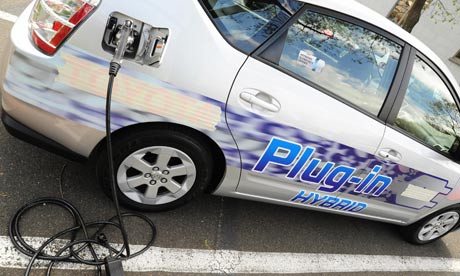
A plug-in version of the Toyota Prius hybrid, similar to the Amerbjac version being offered by Streetcar in London. Photograph: Karen Bleier/AFP/Getty Images
Car club firm Streetcar has this week launched the UK's first electric car hire scheme, offering Londoners the chance to hire a plug-in hybrid version of Toyota's popular Prius.
The modified version of the hybrid car is provided by UK firm Amberjac Projects and features a new lithium ion phosphate battery that can be charged from the mains, allowing the car to travel up to 30 miles without using the conventional engine.
According to reports from the Evening Standard, the Amberjac Prius will be available for Streetcar members to hire from £5.95 an hour.
Speaking to BusinessGreen.com, Streetcar's co-founder Brett Akker said the company's 58,000 car club members would be the first people in Europe to be able to hire a car with plug-in hybrid technology.
He added that if the trial, which is backed by Camden Council and Transport for London, proves popular the company will aim to roll out more plug-in hybrids across the capital.
"Plug-in hybrids have a lot of potential for car clubs," he said. "The Amberjac has a 30 mile range using the battery, which covers around two thirds of our members' journeys, but it can then also be used for any longer journeys. "
The news follows the launch last week of a new initiative that will see some of the capital's largest fleet operators work with City Hall to accelerate the rollout of electric commercial vehicles.
The group, which includes delivery firms DHL, TNT and UPS, as well as supermarkets M&S and Sainsbury's, pledged to increase their electric vehicle fleets and work with the mayor's office on plans to roll out 25,000 charging points across the city by 2015.
"Not only do electric vehicles save a large sum off fuel bills, helping businesses to remain lean in tough economic times, they are also great for London's environment," said Mayor Boris Johnson. "We are now going to work hand in hand with fleet owners to accelerate the take-up of electric vehicles, which are available to buy right now."
Via guardian.co.uk

A plug-in version of the Toyota Prius hybrid, similar to the Amerbjac version being offered by Streetcar in London. Photograph: Karen Bleier/AFP/Getty Images
Car club firm Streetcar has this week launched the UK's first electric car hire scheme, offering Londoners the chance to hire a plug-in hybrid version of Toyota's popular Prius.
The modified version of the hybrid car is provided by UK firm Amberjac Projects and features a new lithium ion phosphate battery that can be charged from the mains, allowing the car to travel up to 30 miles without using the conventional engine.
According to reports from the Evening Standard, the Amberjac Prius will be available for Streetcar members to hire from £5.95 an hour.
Speaking to BusinessGreen.com, Streetcar's co-founder Brett Akker said the company's 58,000 car club members would be the first people in Europe to be able to hire a car with plug-in hybrid technology.
He added that if the trial, which is backed by Camden Council and Transport for London, proves popular the company will aim to roll out more plug-in hybrids across the capital.
"Plug-in hybrids have a lot of potential for car clubs," he said. "The Amberjac has a 30 mile range using the battery, which covers around two thirds of our members' journeys, but it can then also be used for any longer journeys. "
The news follows the launch last week of a new initiative that will see some of the capital's largest fleet operators work with City Hall to accelerate the rollout of electric commercial vehicles.
The group, which includes delivery firms DHL, TNT and UPS, as well as supermarkets M&S and Sainsbury's, pledged to increase their electric vehicle fleets and work with the mayor's office on plans to roll out 25,000 charging points across the city by 2015.
"Not only do electric vehicles save a large sum off fuel bills, helping businesses to remain lean in tough economic times, they are also great for London's environment," said Mayor Boris Johnson. "We are now going to work hand in hand with fleet owners to accelerate the take-up of electric vehicles, which are available to buy right now."











